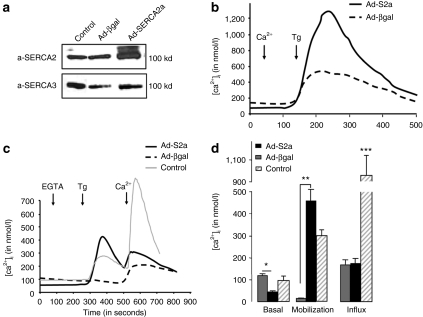Figure 6.
SERCA2a gene transfer modulates calcium cycling in HCAEC. (a) Representative western blot of lysates from HCAEC noninfected or infected either with AAV1.SERCA2a or AAV1.βgal. Expression of SERCA2 and SERCA3 was revealed with an anti-pan SERCA2 (IID8) and an anti-pan SERCA3 (PLIM/430), respectively. (b–d) Effect of SERCA2a overexpression in HCAEC on [Ca2+]i: basal level, mobilization, and capacitative entry. At the time of the experiment (b) 1 mmol/l of CaCl2 (Ca2+) or (c) 100 µmol/l EGTA was added as indicated, and cells were then stimulated with 1 µmol/l of thapsigargin (Tg) for 4 minutes. (b) To observe the calcium capacitative entry, 300 µmol/l of CaCl2 (Ca2+) was then added to the medium. (d) Histograms showing the means ± SEM of the basal level in [Ca2+]i, Ca2+ release in response to Tg, and Ca2+ influx observed after addition of extracellular CaCl2. Representative of eight experiments obtained with four independent infections. (***P < 0.01, **P < 0.01, *P < 0.05 versus βgal). AAV1, adeno-associated virus, βgal, β-galactosidase; EGTA, ethylene glycol tetraacetic acid; HCAEC, human coronary artery endothelial cell; SERCA2a, sarco/endoplasmic reticulum Ca2+-ATPase 2a.

